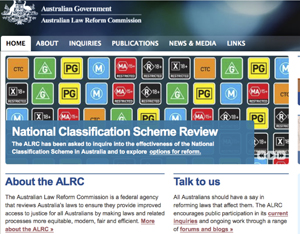Convergent Media Policy: The Australian Case
 2012 has proved to be a remarkably busy year in Australian media policy. There have been three reports released that address the future of media policy and regulation in the context of convergent media: the Convergence Review; the Independent Media Inquiry (Finkelstein Review); and the Review of the National Classification Scheme undertaken by the Australian Law Reform Commission.
2012 has proved to be a remarkably busy year in Australian media policy. There have been three reports released that address the future of media policy and regulation in the context of convergent media: the Convergence Review; the Independent Media Inquiry (Finkelstein Review); and the Review of the National Classification Scheme undertaken by the Australian Law Reform Commission.
It has been the most significant moment in Australian media policy since the early 1990s, when the Broadcasting Services Act and the Telecommunications Act, as well as the Classification Act, were legislated. While these were major initiatives at the time, they were pre-Internet forms of media law that did not anticipate the tsunami of change associated with digitalization, convergence and the globalization of media content.
While other countries are considering changes to adapt their media laws for convergence, Australia has been a world leader in commissioning such major studies that address these challenges head on. A common theme of these reports is that incremental change and policy “muddling through” are no longer sufficient.
In particular, media regulation continues to be primarily based upon the platform of delivery (print, radio, television, telephony, the Internet), whereas media convergence has dislodged the technological bases that tied content to platforms. The Australian Communications and Media Authority has referred to a resulting series of “broken concepts”, ranging from the truly anachronistic, such as the ban on live hypnosis on television, to those which addressed a once-important concept that has been overwhelmed by new developments, such as the separation of carriage and content.
The Convergence Review identified three areas where continued government intervention is justified. First, there is the need to maintain a degree of diversity in media ownership and control. Second, there is the question of content standards, both in terms of news standards and classification of media content in line with community standards. Finally, there are expectations that Australians have around the continued availability of locally produced content that is broadly reflective of Australian culture, identity and diversity.
The question of who should be regulated has become much more complex in a convergent media environment. In discussions of media influence, a distinction is commonly made between “big media” on the one hand who should be regulated more – the name “Rupert Murdoch” will often appear at this juncture – and the Internet on the other, which should not be regulated at all.
But “the Internet” is as much The Guardian Online, BBC World or CNN.com as it is blogging, citizen journalism, or online mash-ups. The commercial mass media and non-commercial user-created content co-exist in the online digital space, so questions of media influence return in a different form.
The Convergence Review sought to address that question of when a media organization becomes “big”—and hence appropriately subject to regulations based on its potential for influence—with the concept of a “Content Service Enterprise” (CSE). The Review defined a CSE as a media content provider that has over 500,000 Australian users per month, and $50m per annum of revenues from Australian-sourced professional content. Interestingly, the 15 companies that met these guidelines are all conventional media businesses, but the CSE label could in principle be extended to companies such as Google and Apple.
If the CSE concept were extended to global media companies, the question would arise of Australian jurisdictional authority over these businesses. At present, there is a regulatory stand-off, but it may be that future jurisdictional authority will be shared and brokered between Australian agencies and other authorities. In the ALRC Review, this was referred to as deeming, where the classifications given to media content by online “stores” such as Apple ITunes or the Google Android platform could be recognized under Australian media law, subject to approval by the Australian regulators.
Much attention has been given to the question of “who regulates”. One of the difficulties with these discussions is that we think of regulation in terms of how much, rather than in terms of the relationship between its instruments and its outcomes. One message that came through from the ALRC Review was that Australians were less concerned with who classified different media than with the question of trusting those doing it to have an appropriate professional distance from corporate self-interest.
Another difficulty is that convergent media policy brings together different organizational cultures and traditions of regulation. Whereas it is still pretty clear who constitutes the television industry or the newspaper industry, it is less clear what constitutes the Internet, digital content or social media industries.
Meeting with Apple, Google, Facebook or Microsoft introduces you to very different corporate entities, with very different organizational cultures, business models, and relationships to their consumers. Establishing a new regulatory framework for convergent media raises not only the challenges of established media operating across different platforms, but the ever-growing fluidity attached to the concept of “media” itself.


